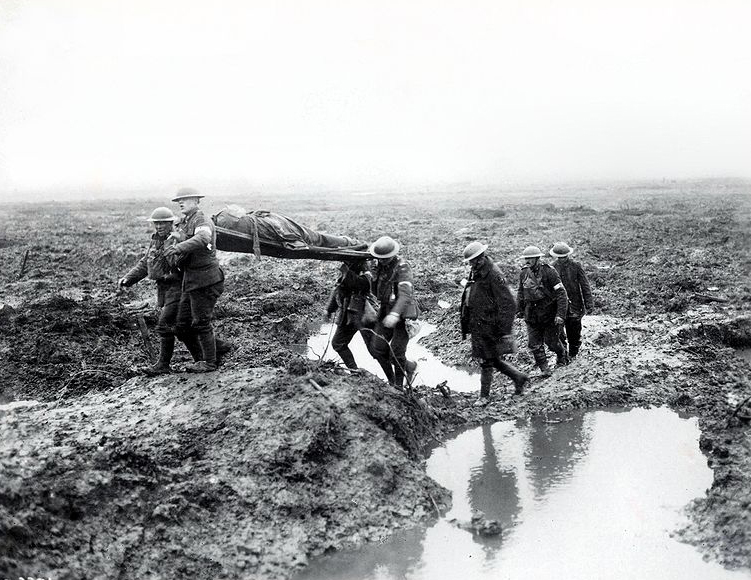
“The images have unlocked a story that has been hidden for a century.”
HUNDREDS OF THOUSANDS of men were interned in Great Britain during the First World War. Some were citizens of hostile countries who happened to be present in the United Kingdom when the fighting erupted in August 1914. Others were brought to Britain from all over the empire. Most were prisoners-of-war – captured enemy soldiers from the Western Front, along with sailors and even the crews of downed Zeppelins.
They were housed in camps across Great Britain; many spent years behind barbed wire far from their families.
Now more than a century later, a collection of previously unseen photographs from the camps of the era reveal what life was like for these internees and prisoners of war.
The images, which were discovered in the archives of the 150-year-old British photography studio W.W. Winter, will be on display at the University of Derby from Oct. 25 to Jan. 3, 2020. The exhibit is part of a larger research project involving historians from the University of Nottingham and W.W. Winter Heritage Trust in Derby.
Jane Middleton-Smith of W.W. Winter first unearthed the collection of glass-plate negatives and prints, which were captured by the company’s photographers at a POW camp in Sutton Bonington around 1917. Over the past two years, she and W.W. Winter staff have been working with researchers at the universities of Nottingham and Derby on the collection. The 54 images on exhibit show captive German prisoners, including some high-profile and senior-ranking military and naval officers.
The prints provided new insights into the prisoners, conditions in the camps and even details about some of the dramatic escape attempts made by some of the men.
The camp at Sutton Bonington was actually part of a dual site, comprising the Midland Agricultural College – now the university’s Biosciences and Veterinary Medicine campus – and Donington Hall, a stately home in the area. As many as 200 German army and navy officers and orderlies, along with a handful of Austrian and Ottoman personnel, and even a few civilians, were held there between 1915 and 1919.
“The First World War is popularly regarded as having taking place abroad, most famously in the trenches of Northern France and Belgium,” said Mike Noble, a historian from the University of Nottingham. “However, as these remarkable images reveal, a great deal of the territory of the U.K. was used for military purposes. Everyday locations, such as colleges, were militarized, which brought the war into local neighbourhoods. It is striking to see familiar buildings, Sutton Bonington and Donington Hall, with populations of uniformed German personnel.”

Like all camps, Donington was subject to independent inspection. In 1916, this was performed by delegates from the then-neutral United States. American embassy staff visited the camp on June 9, 1916, when it was home to 194 prisoners. The envoys observed three tennis courts, a skittles alley, a makeshift hockey rink and football pitch, along with paths for leisurely walks through the “beautiful country.” The men were happy and contented and none had any complaints, the visitors observed.
Not surprisingly, the camp attracted negative public attention for the reportedly comfortable luxurious conditions inside. In fact, some characterized inmates as enjoying a “champagne lifestyle.” Harold Tennant, the Under-Secretary of State for War, was even grilled by MPs in the House of Commons over the issue.
The more fanciful tales of lavish conditions were later dispelled by journalists who visited in July 1916. With mischievous embellishment, the Manchester Guardian’s George Leach described the common stories of Donington’s “American bar, where Fifth Avenue cocktails and Midland sherry cobblers were mixed by scions of the highest aristocracy” and “games of polo in the park on ponies provided by the female cousins of Cabinet Ministers.” Instead, Leach outlined the modest limit of “a shilling a day” with which the captive officers were permitted to buy light wines and beers, to be consumed in rooms of the “plainest furniture” with uncarpeted floors followed by sleep in dormitories of 18 beds. The “luxurious Donington,” he concluded, was nothing more than a myth.
In fact, one of the most significant problems faced by prisoners was boredom. This was especially the case during the early stages of the war, when most captives sat idle. Sport and other physical activity were added later to help relieve the tedium of camp life.

Of course, all military prisoners were duty-bound to attempt escape and this was certainly true of the East Midlands prisoners. In September of 1917, 23 prisoners managed to dig a tunnel and flee. Once free, they raced to put much distance between themselves and the camp as possible. All were swiftly recaptured. The only successful escape, indeed the only successful escape by any POW held in Britain in either world war, was carried out by the German aviator Gunther Plüschow, who made it back to Germany via the Netherlands in July 1915.
Prisoners experienced relatively low death rates. The most common cause of death were injuries sustained on the battlefield prior to capture. However, hundreds of prisoners perished during the Influenza pandemic, which affected many camps, including Donington, in 1918 and 1919.
The camp was decommissioned over several months in 1919 and the prisoners were repatriated. Details about it were gradually forgotten, until now.
“The images have unlocked a story that has been hidden for a century,” said Middleton-Smith.










1 thought on “Life in Captivity – Unearthed Photos Reveal Hidden Histories of WW1 German POWs”